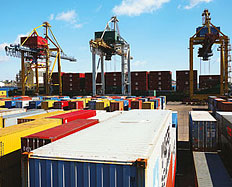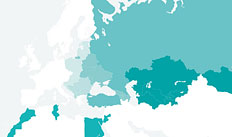Chapter 4
Non-tariff barriers to trade
Not all of the increase in trade between the Customs Union members shown in Chart 4.2 can be explained by tariffs, recovery effects and past trade levels, as indicated by the fact that the regression constant in Table 4.1 is positive and statistically significant in all cases. The lowering of non-tariff barriers within the Union may also be a factor. Non-tariff and “behind the border” barriers take various forms, including corrupt customs officials, inadequate transport infrastructure and poor business environment. Obstacles of this kind are less visible than tariff barriers and harder to measure, but no less important. For example, a recent study estimated that one extra day spent by goods in transit is equivalent to an additional tariff of between 0.6 and 2.3 per cent.23
Source: Kazstat, Rosstat, Belstat and Customs Union Commission.
Note: CU is the Customs Union of Belarus, Kazakhstan and Russia, EU-27 are the 27 current members of the European Union.
| 0 | Kazakhstan | 2 | 3 | 4 | 5 | Belarus | 7 | 8 | 9 | 10 | Russia | 12 | 13 | 14 | 15 |
|---|---|---|---|---|---|---|---|---|---|---|---|---|---|---|---|
| Dependent variable:change in imports | World | CU | EU | China | CIS | World | CU | EU | China | CIS | World | CU | EU | China | CIS |
| Change in tariffs | 0.0024 | 0.0076* | -0.0056 | -0.0141** | 0.0009 | -0.0133*** | 0.0077 | -0.0233*** | -0.0078 | -0.0015 | -0.0114*** | 0.0026 | -0.0099** | -0.0128** | -0.0061 |
| (0.0028) | (0.0039) | (0.0049) | (0.0071) | (0.0136) | (0.0032) | (0.006) | (0.0049) | (0.0132) | (0.013) | (0.0032) | (0.0084) | (0.0039) | (0.0051) | (0.012) | |
| Change in bilateral imports, 2006-08 | 0.0068 | -0.0556 | -0.1514*** | 0.0101 | 0.1102*** | -0.0033 | 0.0771 | -0.0028 | 0.0243 | -0.0721*** | -0.0495*** | 0.0553 | |||
| (0.0372) | (0.0459) | (0.0447) | (0.0579) | (0.0423) | (0.036) | (0.0491) | (0.0548) | (0.023) | (0.0258) | (0.0183) | (0.036) | ||||
| Change in bilateral imports, 2008-09 | -0.2622*** | -0.3146*** | -0.4621*** | -0.3133** | -0.3940*** | -0.3118*** | -0.0424 | -0.3606*** | -0.1474*** | -0.3024*** | -0.2980*** | -0.2346*** | |||
| (0.0507) | (0.0675) | (0.0877) | (0.1275) | (0.0594) | (0.0688) | (0.148) | (0.0916) | (0.053) | (0.0338) | (0.032) | (0.0531) | ||||
| Bilateral imports, 2009, log | -0.1267*** | -0.1495*** | -0.1569*** | -0.3110*** | -0.0452** | -0.1012*** | -0.1469** | -0.033 | -0.0567*** | -0.0606*** | -0.0499*** | -0.0807*** | |||
| (0.0217) | (0.0284) | (0.0429) | (0.0753) | (0.0191) | (0.0208) | (0.0599) | (0.0477) | (0.0196) | (0.0082) | (0.012) | (0.0217) | ||||
| Change in world imports, 2006-08 | -0.1020*** | -0.033 | 0.0479 | -0.0153 | -0.2297** | -0.0195 | -0.1110** | -0.0931* | -0.0581 | -0.0145 | -0.0651*** | 0.0143 | 0.0112 | 0.0562 | -0.0166 |
| (0.0198) | (0.0509) | (0.0662) | (0.0752) | (0.1010) | (0.0163) | (0.0536) | (0.0483) | (0.0964) | (0.1061) | (0.0128) | (0.0479) | (0.0319) | (0.0342) | (0.053) | |
| Change in world imports, 2008-09 | -0.3218*** | 0.069 | -0.2468*** | 0.1664 | -0.1135 | -0.3655*** | 0.0394 | -0.1654** | -0.1143 | 0.1658 | -0.2625*** | -0.1473*** | 0.0462 | 0.1983*** | -0.0564 |
| (0.0294) | (0.0620) | (0.0907) | (0.1116) | (0.1837) | (0.0263) | (0.0759) | (0.0819) | (0.1974) | (0.1411) | (0.0174) | (0.0542) | (0.0376) | (0.0453) | (0.0713) | |
| World imports, 2009, log | -0.1111*** | -0.0500*** | -0.0446*** | ||||||||||||
| (0.0129) | (0.0104) | (0.006) | |||||||||||||
| Constant | 0.7099*** | 0.3902** | 0.9338*** | 1.5044*** | 2.4767*** | 0.4791*** | 0.4085** | 0.8852*** | 1.3077*** | 0.3447 | 0.6569*** | 0.5253*** | 0.7264*** | 0.8743*** | 0.8454*** |
| (0.1159) | (0.1978) | (0.2460) | (0.3662) | (0.6562) | (0.0891) | (0.1605) | (0.1736) | (0.4675) | (0.3884) | (0.0581) | (0.1731) | (0.0776) | (0.1064) | (0.1959) | |
| Number of observations | 1323 | 486 | 542 | 295 | 156 | 1578 | 640 | 747 | 143 | 187 | 2917 | 508 | 2084 | 1250 | 460 |
| R-squared | 0.176 | 0.1821 | 0.2995 | 0.2221 | 0.3393 | 0.1605 | 0.1795 | 0.257 | 0.1138 | 0.1374 | 0.109 | 0.0726 | 0.1293 | 0.1061 | 0.145 |
| Number of industry fixed effects | 133 | 99 | 93 | 77 | 55 | 147 | 109 | 119 | 55 | 66 | 162 | 109 | 151 | 136 | 106 |
Source: Authors' calculations.
Note: The table shows the results of ordinary least squares regressions of changes in imports in 2009-10 (in logarithmic terms). Robust standard errors in parentheses.
Values significant at the 10 per cent level are marked with *; at the 5 per cent level with **; at the 1 per cent level with ***. A negative coefficient for the change in tariffs means that imports decreased in response to a higher tariff or that tariff increased in response to a lower import tariff.
Regional economic integration creates multiple opportunities for lowering non-tariff barriers. For example, customs controls have been removed from Russia’s borders with Belarus and Kazakhstan with the introduction of the Customs Union and the Asian Development Bank (ADB) has evidence that crossing the Kazakh-Russian border has indeed become substantially easier. The need for intermediary or facilitation payments may have also been reduced, in turn helping trade. At the same time, clearance times on the Kazakh border for trucks entering from non-Customs Union CIS countries (such as the Kyrgyz Republic) have increased significantly by up to 47 per cent.24
The 2008-09 round of the Business Environment and Enterprise Performance Survey (BEEPS), conducted just before the Customs Union was established, suggested that customs procedures were viewed as especially burdensome by firms in CIS countries and the Union in particular. Survey respondents (directors, owners or senior managers of firms) evaluated various elements of the public infrastructure and business environment, including trade regulations and customs, in terms of their perceived constraint on firms’ operations. For example, trade regulations and customs were ranked on a five-point scale of obstruction (ranging from none to severe). Approximately 30 per cent of firms in Belarus, Kazakhstan and Russia which traded across borders viewed them as a serious problem, while only around 10 per cent did so in the new EU member states (the EU‑10) (see Chart 4.4a).
Source: BEEPS Survey and authors’ calculations.
Note: Based on 2008-09 data.
Source: BEEPS Survey and authors’ calculations.
Note: Based on preliminary data.
The most recent round of the BEEPS survey in Russia also provides some indirect evidence of reduced non-tariff barriers in the Customs Union. This round included, for the first time, representative samples from 37 regions of Russia. Four of them (Omsk, Chelyabinsk, Novosibirsk and Smolensk regions) border Belarus or Kazakhstan, while 11 share a frontier with other countries.
Of those companies exporting or importing goods directly, 27 per cent viewed customs and trade regulations as a major or very severe obstacle to their operations, a result broadly similar to that in the 2008-09 survey round. However, the percentage was significantly lower in regions bordering Belarus and Kazakhstan (12 per cent) than in those bordering other countries (31 per cent – see Chart 4.4b). This result also held when the obstacle variable was regressed on various firm characteristics and when the propensity of respondents to feel constrained by various other aspects of the business environment was taken into account: the difference in coefficients on the dummies for regions bordering Belarus and Kazakhstan and other border regions has the expected sign and is statistically significant. While the survey did not collect the data on destinations of trade, the evidence indirectly supports the view that trade with Belarus and Kazakhstan is subject to lower effective barriers.
In order to analyse the effect of customs as a barrier to trade more broadly, Table 4.3 looks at the experience of 24 exporters in emerging Europe and Central Asia. A gravity model of trade is used to explain export flows from these countries to key destinations worldwide. In particular, the size of bilateral trade flows in 2010 is explained by the average tariff that exports from a given country face at the border of the country of destination,25 the distance between trading partners, whether they share a border and a number of characteristics of exporter countries (including access to the sea, GDP level and population size). The regressions also include a constant (fixed effect) for each importer to capture the fact that export volumes may depend on importer characteristics. Column 1 in the table shows that larger economies export more and that distance has the expected negative effect on trade. Sharing a border increases exports by about 45 per cent. Access to the sea also increases trade, by around 25 per cent.
Tariff barriers do have a negative impact on trade. A 1 percentage point reduction in the tariff faced by a country’s exports of a particular type of product at the destination border is associated with a 4 per cent rise in exports to that country. However, as exports in the sample face an effective average tariff of around 2.5 per cent (non-weighted), total gains from reducing tariff barriers, while sizeable, are ultimately limited.
Column 2 adds a measure of the quality of customs and trade regulations based on BEEPS data, namely the percentage of exporting firms which view customs as a major or very severe obstacle to their operations. Its effect is large and highly significant: improving customs procedures from the average level of the Customs Union countries (where on average 29 per cent of firms see customs as a major or very severe obstacle) to that in the Baltic states (where the figure is only 10 per cent) would bring about a 44 per cent increase in exports. Column 3 confirms that this significant effect persists when controlling for a broader measure of institutions as well as the quality of infrastructure.
These results provide further evidence that the benefits of improving customs procedures within the Customs Union could be substantial. However, while progress to date has been encouraging, a number of additional non-trade barriers within the Common Economic Space have yet to be fully removed. In particular, technical and sanitary regulations are yet to be harmonised, and in many cases firms are still subject to national-level inspection and certification of their produce. Moreover, the legal regime governing imports into the Customs Union, which is underpinned by national and supranational legislation, is complicated and may entail increased compliance costs, in particular for smaller businesses.26 Furthermore, there is a clear need to reduce non-tariff barriers in respect of export and import trade between Customs Union members and other countries.27
Another important non-tariff dimension that can severely constrain trade is poor infrastructure, including cross-border infrastructure. Trade relies on good roads, railways and ports and on sufficient capacity at customs checkpoints. Analysis shows that the potential gains from improvements in cross-border infrastructure far exceed the effects of lowering tariff barriers to trade (see Box 4.4). Such gains are greatest when improvements in infrastructure are simultaneous and complementary. For example, a good road on one side of a border may be of limited use if it does not meet a comparable connection on the other. The Common Economic Space can provide a framework for coordinating upgrades to the capacity of transport corridors and improvements in other infrastructure linkages, and can draw on the experience in this respect of other regional unions, including the European Union and the GCC.
23 See Hummels and Schaur (2012).
24 ADB (2012), based on the Corridor Performance Management and Monitoring data of the Central Asia Regional Economic Cooperation Programme
25 The average effective tariffs are computed for individual industries at the two-digit level of disaggregation – this includes industries such as processed food or durable goods.
26 See Dragneva-Lewers (2012).
27 See also Racine (2011) for a recent discussion of non-tariff barriers in the region.







